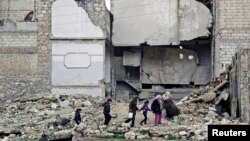Delegates attending a U.N.-sponsored meeting on the crisis in Syria are appealing to all warring factions to allow humanitarian agencies to deliver desperately needed aid to millions of people who currently are out of reach.
Representatives from governments and major aid agencies are meeting this week to discuss the nuts and bolts of humanitarian operations in Syria, neighboring countries of refuge and Iraq.
The meeting, called by the Organization for the Coordination of Humanitarian Affairs or OCHA, is putting a particular focus on the increasingly dire situation faced by Syrian civilians both inside and outside the country.
Climbing death toll
Next month Syria will enter its fifth year of war. The casualty toll is staggering with an estimated 200,000 people killed, 7.6 million internally displaced and more than 3.2 million refugees in Lebanon, Jordan, Turkey, Iraq, and Egypt.
Syria is considered the world’s worst humanitarian crisis with more than half of Syria’s population of 12.2 million in need of assistance.
Kelly Clements, deputy assistant secretary for the U.S. State Department’s Bureau of Population, Refugees, and Migration, said providing aid in this conflict-ridden country is extremely difficult and dangerous. She noted that the most pressing problem is getting access to hundreds of thousands of needy people in areas that essentially are off limits.
“Nearly a quarter of a million Syrians today are living in areas besieged by violence and a large portion of them require food supplies and urgent medical care," she said. "The U.N. currently has no access to 600,000 people residing in ISIL-controlled Raqqa and Deir ez-Zor and most large NGOs [non-governmental organizations] have also ceased operations. 2.8 million of the 12.2 million that I mentioned earlier are in ISIL-controlled areas.”
In addition, Clements said the U.N. Relief and Works Agency has been unable to deliver aid for more than two months to some 18,000 Palestinians trapped in the Yarmouk refugee camp in Damascus.
Seeking assistance
The United States is the single largest donor of humanitarian assistance in the Syrian crisis. It has provided more than $3 billion since the start of the conflict and has just announced an additional $125 million in humanitarian aid to the U.N. World Food Program, which feeds nearly 6 million Syrians inside the country and in neighboring countries of refuge every month.
Clements told VOA the number of victims created in so many different ways by the Syrian conflict is eye-popping. She expressed some reservations, though, about the almost obsessive emphasis placed upon numbers.
“It is probably better to talk about people and the people that are behind the numbers because we get a little numb by the numbers in terms of just the enormity of the humanitarian catastrophe on the ground right now," said Clements.
"And I do not want to dizzy with numbers when it is really lives we are talking about and the situation is getting worse by the day. And even though we are getting a lot of resources in there, we are not even close to meeting humanitarian need. And so the gap is growing very, very quickly and the desperation by many even faster,” said Clements.
Kuwait will be hosting the third donor-pledging conference for Syria next month. At that time, Clements said the United States will announce a substantial increase in the amount of money it plans to give for humanitarian assistance to Syrian war victims. She said Washington is calling on other governments to do the same.






